Financial Analysis of Vodafone Group PLC: Cost, Valuation, and Forex
VerifiedAdded on 2023/04/11
|9
|2651
|230
Report
AI Summary
This report provides a detailed financial analysis of Vodafone Group PLC, examining its cost of capital, company valuation, and foreign exchange issues. The analysis begins with calculating the cost of capital, including the cost of equity (17.69%) and the cost of debt (4.68%), leading to a Weighted Average Cost of Capital (WACC) of 13.47%. The report then proceeds to value the company using Free Cash Flow to the Firm (FCFF) and Free Cash Flow to Equity (FCFE) models, resulting in a firm value of Euro 27906 million and an equity value of Euro 4268 million. The report highlights the differences between FCFF and FCFE, emphasizing the importance of the FCFE model when the capital structure is stable. Finally, the report addresses foreign exchange issues related to finance raised bonds in different currencies, including the distinctions between euro bonds and foreign bonds, and the rise of Islamic bonds (Sukuk).
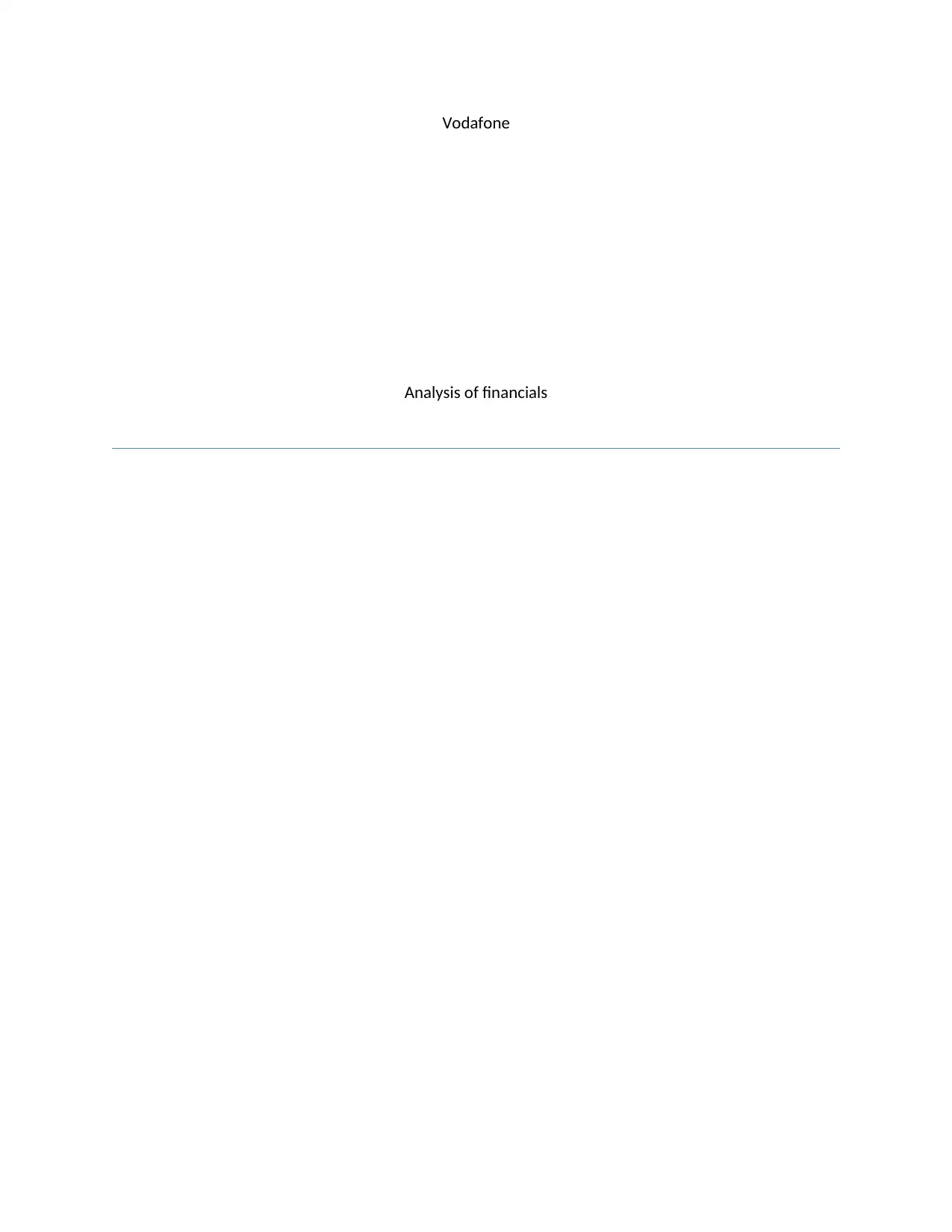
Vodafone
Analysis of financials
Analysis of financials
Paraphrase This Document
Need a fresh take? Get an instant paraphrase of this document with our AI Paraphraser
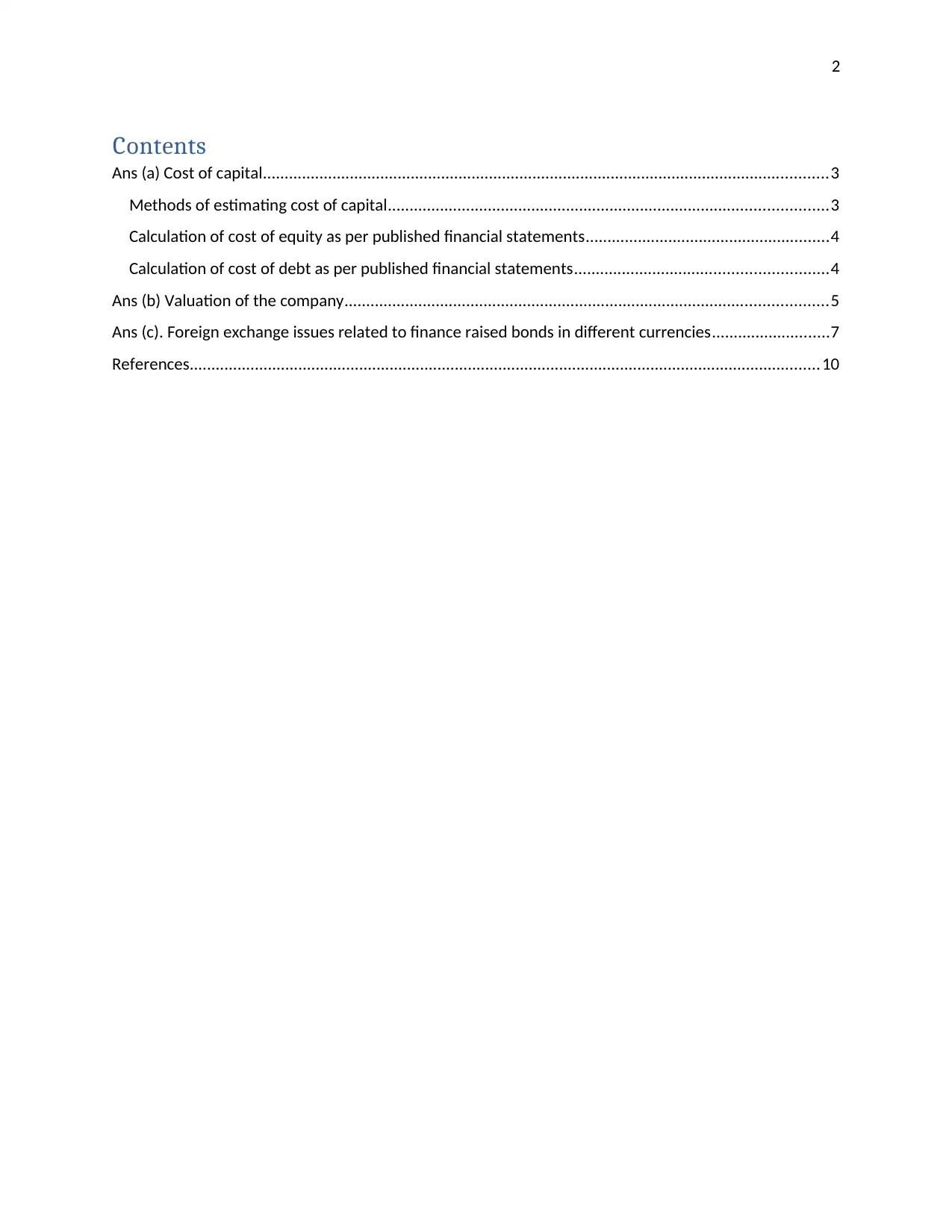
2
Contents
Ans (a) Cost of capital..................................................................................................................................3
Methods of estimating cost of capital.....................................................................................................3
Calculation of cost of equity as per published financial statements........................................................4
Calculation of cost of debt as per published financial statements..........................................................4
Ans (b) Valuation of the company...............................................................................................................5
Ans (c). Foreign exchange issues related to finance raised bonds in different currencies...........................7
References.................................................................................................................................................10
Contents
Ans (a) Cost of capital..................................................................................................................................3
Methods of estimating cost of capital.....................................................................................................3
Calculation of cost of equity as per published financial statements........................................................4
Calculation of cost of debt as per published financial statements..........................................................4
Ans (b) Valuation of the company...............................................................................................................5
Ans (c). Foreign exchange issues related to finance raised bonds in different currencies...........................7
References.................................................................................................................................................10
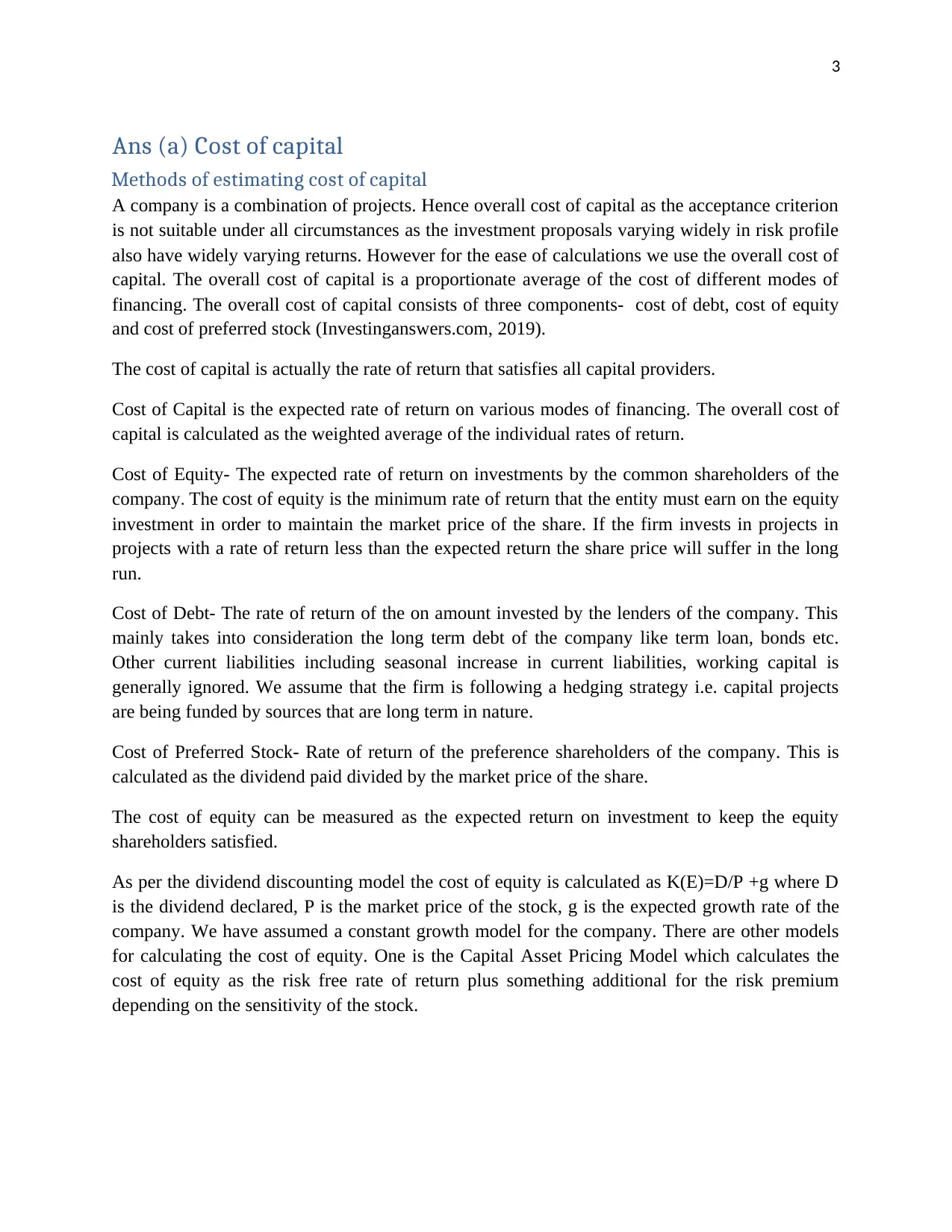
3
Ans (a) Cost of capital
Methods of estimating cost of capital
A company is a combination of projects. Hence overall cost of capital as the acceptance criterion
is not suitable under all circumstances as the investment proposals varying widely in risk profile
also have widely varying returns. However for the ease of calculations we use the overall cost of
capital. The overall cost of capital is a proportionate average of the cost of different modes of
financing. The overall cost of capital consists of three components- cost of debt, cost of equity
and cost of preferred stock (Investinganswers.com, 2019).
The cost of capital is actually the rate of return that satisfies all capital providers.
Cost of Capital is the expected rate of return on various modes of financing. The overall cost of
capital is calculated as the weighted average of the individual rates of return.
Cost of Equity- The expected rate of return on investments by the common shareholders of the
company. The cost of equity is the minimum rate of return that the entity must earn on the equity
investment in order to maintain the market price of the share. If the firm invests in projects in
projects with a rate of return less than the expected return the share price will suffer in the long
run.
Cost of Debt- The rate of return of the on amount invested by the lenders of the company. This
mainly takes into consideration the long term debt of the company like term loan, bonds etc.
Other current liabilities including seasonal increase in current liabilities, working capital is
generally ignored. We assume that the firm is following a hedging strategy i.e. capital projects
are being funded by sources that are long term in nature.
Cost of Preferred Stock- Rate of return of the preference shareholders of the company. This is
calculated as the dividend paid divided by the market price of the share.
The cost of equity can be measured as the expected return on investment to keep the equity
shareholders satisfied.
As per the dividend discounting model the cost of equity is calculated as K(E)=D/P +g where D
is the dividend declared, P is the market price of the stock, g is the expected growth rate of the
company. We have assumed a constant growth model for the company. There are other models
for calculating the cost of equity. One is the Capital Asset Pricing Model which calculates the
cost of equity as the risk free rate of return plus something additional for the risk premium
depending on the sensitivity of the stock.
Ans (a) Cost of capital
Methods of estimating cost of capital
A company is a combination of projects. Hence overall cost of capital as the acceptance criterion
is not suitable under all circumstances as the investment proposals varying widely in risk profile
also have widely varying returns. However for the ease of calculations we use the overall cost of
capital. The overall cost of capital is a proportionate average of the cost of different modes of
financing. The overall cost of capital consists of three components- cost of debt, cost of equity
and cost of preferred stock (Investinganswers.com, 2019).
The cost of capital is actually the rate of return that satisfies all capital providers.
Cost of Capital is the expected rate of return on various modes of financing. The overall cost of
capital is calculated as the weighted average of the individual rates of return.
Cost of Equity- The expected rate of return on investments by the common shareholders of the
company. The cost of equity is the minimum rate of return that the entity must earn on the equity
investment in order to maintain the market price of the share. If the firm invests in projects in
projects with a rate of return less than the expected return the share price will suffer in the long
run.
Cost of Debt- The rate of return of the on amount invested by the lenders of the company. This
mainly takes into consideration the long term debt of the company like term loan, bonds etc.
Other current liabilities including seasonal increase in current liabilities, working capital is
generally ignored. We assume that the firm is following a hedging strategy i.e. capital projects
are being funded by sources that are long term in nature.
Cost of Preferred Stock- Rate of return of the preference shareholders of the company. This is
calculated as the dividend paid divided by the market price of the share.
The cost of equity can be measured as the expected return on investment to keep the equity
shareholders satisfied.
As per the dividend discounting model the cost of equity is calculated as K(E)=D/P +g where D
is the dividend declared, P is the market price of the stock, g is the expected growth rate of the
company. We have assumed a constant growth model for the company. There are other models
for calculating the cost of equity. One is the Capital Asset Pricing Model which calculates the
cost of equity as the risk free rate of return plus something additional for the risk premium
depending on the sensitivity of the stock.
⊘ This is a preview!⊘
Do you want full access?
Subscribe today to unlock all pages.

Trusted by 1+ million students worldwide
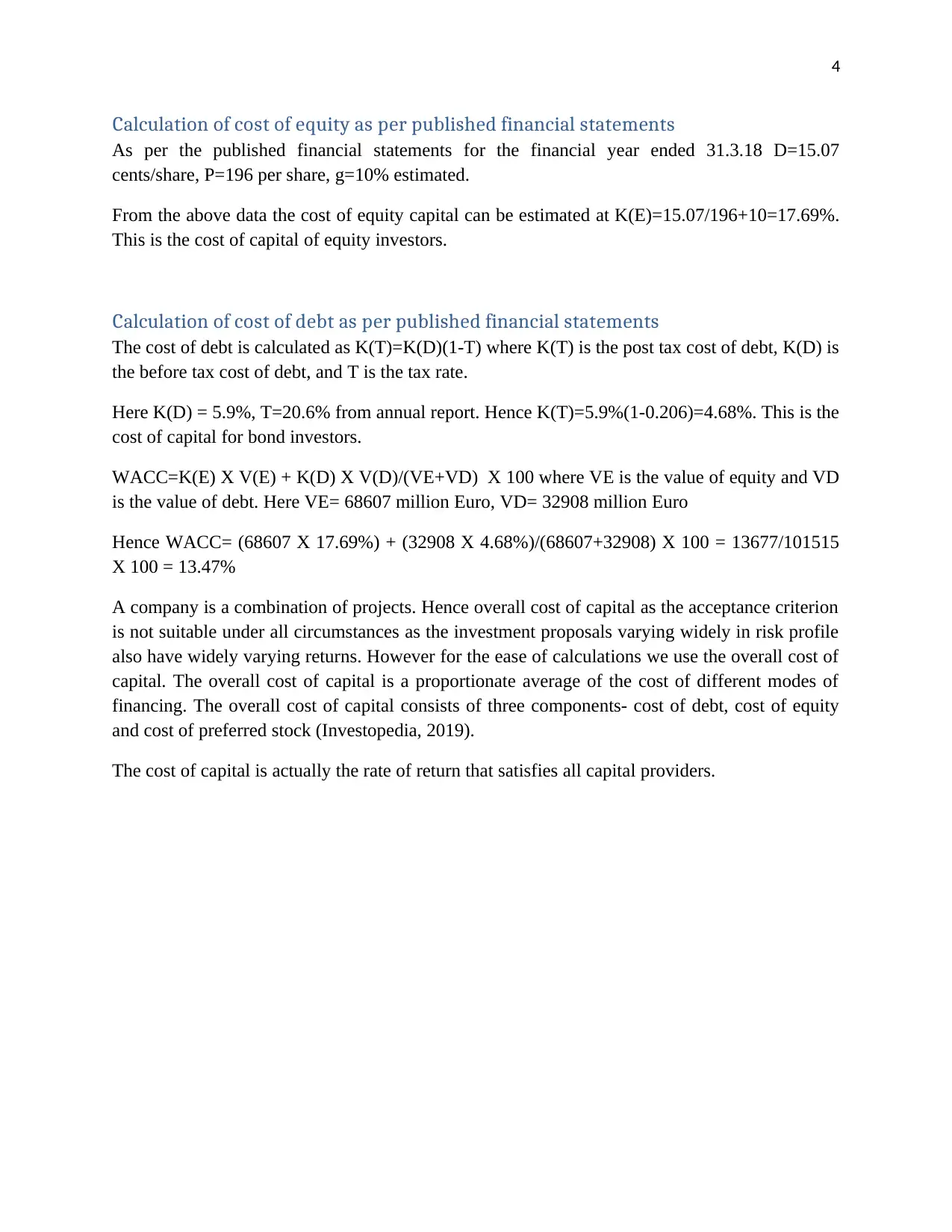
4
Calculation of cost of equity as per published financial statements
As per the published financial statements for the financial year ended 31.3.18 D=15.07
cents/share, P=196 per share, g=10% estimated.
From the above data the cost of equity capital can be estimated at K(E)=15.07/196+10=17.69%.
This is the cost of capital of equity investors.
Calculation of cost of debt as per published financial statements
The cost of debt is calculated as K(T)=K(D)(1-T) where K(T) is the post tax cost of debt, K(D) is
the before tax cost of debt, and T is the tax rate.
Here K(D) = 5.9%, T=20.6% from annual report. Hence K(T)=5.9%(1-0.206)=4.68%. This is the
cost of capital for bond investors.
WACC=K(E) X V(E) + K(D) X V(D)/(VE+VD) X 100 where VE is the value of equity and VD
is the value of debt. Here VE= 68607 million Euro, VD= 32908 million Euro
Hence WACC= (68607 X 17.69%) + (32908 X 4.68%)/(68607+32908) X 100 = 13677/101515
X 100 = 13.47%
A company is a combination of projects. Hence overall cost of capital as the acceptance criterion
is not suitable under all circumstances as the investment proposals varying widely in risk profile
also have widely varying returns. However for the ease of calculations we use the overall cost of
capital. The overall cost of capital is a proportionate average of the cost of different modes of
financing. The overall cost of capital consists of three components- cost of debt, cost of equity
and cost of preferred stock (Investopedia, 2019).
The cost of capital is actually the rate of return that satisfies all capital providers.
Calculation of cost of equity as per published financial statements
As per the published financial statements for the financial year ended 31.3.18 D=15.07
cents/share, P=196 per share, g=10% estimated.
From the above data the cost of equity capital can be estimated at K(E)=15.07/196+10=17.69%.
This is the cost of capital of equity investors.
Calculation of cost of debt as per published financial statements
The cost of debt is calculated as K(T)=K(D)(1-T) where K(T) is the post tax cost of debt, K(D) is
the before tax cost of debt, and T is the tax rate.
Here K(D) = 5.9%, T=20.6% from annual report. Hence K(T)=5.9%(1-0.206)=4.68%. This is the
cost of capital for bond investors.
WACC=K(E) X V(E) + K(D) X V(D)/(VE+VD) X 100 where VE is the value of equity and VD
is the value of debt. Here VE= 68607 million Euro, VD= 32908 million Euro
Hence WACC= (68607 X 17.69%) + (32908 X 4.68%)/(68607+32908) X 100 = 13677/101515
X 100 = 13.47%
A company is a combination of projects. Hence overall cost of capital as the acceptance criterion
is not suitable under all circumstances as the investment proposals varying widely in risk profile
also have widely varying returns. However for the ease of calculations we use the overall cost of
capital. The overall cost of capital is a proportionate average of the cost of different modes of
financing. The overall cost of capital consists of three components- cost of debt, cost of equity
and cost of preferred stock (Investopedia, 2019).
The cost of capital is actually the rate of return that satisfies all capital providers.
Paraphrase This Document
Need a fresh take? Get an instant paraphrase of this document with our AI Paraphraser

5
Ans (b) Valuation of the company
In the free cash flow valuation technique we value the company by discounting the expected
future cash flows at the required rate of return. There are two values to estimate which are given
below.
Firm Value= FCFF discounted at WACC where FCFF is the free cash flow to the firm
From the cash flow statement of the firm, FCFF=Cash inflow from operating activities + Cash
inflow from investing activities= Euro(13600-9841) million=Euro 3759 million
Considering that the business will continue into the foreseeable future the we calculate the value
as V=FCFF/WACC=Euro (3759/13.47%) million= Euro 27906 million
Equity Value= FCFE discounted at K(E) where FCFE is the free cash flow attributable to equity
shareholders.
From the cash flow statement FCFE= Cash flow from operating activity + Cash flow from
investing activity + Cash flow from financing activity – Dividend paid to equity shareholders
= Euro (13600-9841-7234+4230) million= Euro 755 million
Hence Equity Value= Euro (755/17.69%) million= Euro 4268 million
The difference between FCFF and FCFE is due to the difference in capital structure and reflect
the viewpoints of the different providers of capital. Valuation using FCFE is more useful when
the company’s capital structure is stable. On the contrary if the FCFE is negative and there is
significant debt outstanding we generally use the FCFF model.
Here the firm is considered as a cash processor. Cash flows in to the business in the form of sales
revenue. Cash flows out of the business in the form of payment of various expenses, investments
in working capital, purchase of fixed assets etc. The cash that is left is available for payment to
it’s investors like shareholders and bond holders. This is the free cash flow to the firm (FCFF)
and is discounted to calculate the firm value. The cash that is left after interest payment to
lenders is the free cash flow to equity (FCFE) and is used in paying dividend to equity
shareholders and retained in the business. This is discounted to arrive at the equity value of the
firm (Schmidle, 2006).
The free cash flow based valuation is considered better than the dividend based valuation
because of the following reasons:
1. Many firms pay low dividend or no dividend at all.
2. Dividend payment is the discretion of the board of directors. This may reflect poorly on
the firm’s valuation in the long run.
Ans (b) Valuation of the company
In the free cash flow valuation technique we value the company by discounting the expected
future cash flows at the required rate of return. There are two values to estimate which are given
below.
Firm Value= FCFF discounted at WACC where FCFF is the free cash flow to the firm
From the cash flow statement of the firm, FCFF=Cash inflow from operating activities + Cash
inflow from investing activities= Euro(13600-9841) million=Euro 3759 million
Considering that the business will continue into the foreseeable future the we calculate the value
as V=FCFF/WACC=Euro (3759/13.47%) million= Euro 27906 million
Equity Value= FCFE discounted at K(E) where FCFE is the free cash flow attributable to equity
shareholders.
From the cash flow statement FCFE= Cash flow from operating activity + Cash flow from
investing activity + Cash flow from financing activity – Dividend paid to equity shareholders
= Euro (13600-9841-7234+4230) million= Euro 755 million
Hence Equity Value= Euro (755/17.69%) million= Euro 4268 million
The difference between FCFF and FCFE is due to the difference in capital structure and reflect
the viewpoints of the different providers of capital. Valuation using FCFE is more useful when
the company’s capital structure is stable. On the contrary if the FCFE is negative and there is
significant debt outstanding we generally use the FCFF model.
Here the firm is considered as a cash processor. Cash flows in to the business in the form of sales
revenue. Cash flows out of the business in the form of payment of various expenses, investments
in working capital, purchase of fixed assets etc. The cash that is left is available for payment to
it’s investors like shareholders and bond holders. This is the free cash flow to the firm (FCFF)
and is discounted to calculate the firm value. The cash that is left after interest payment to
lenders is the free cash flow to equity (FCFE) and is used in paying dividend to equity
shareholders and retained in the business. This is discounted to arrive at the equity value of the
firm (Schmidle, 2006).
The free cash flow based valuation is considered better than the dividend based valuation
because of the following reasons:
1. Many firms pay low dividend or no dividend at all.
2. Dividend payment is the discretion of the board of directors. This may reflect poorly on
the firm’s valuation in the long run.
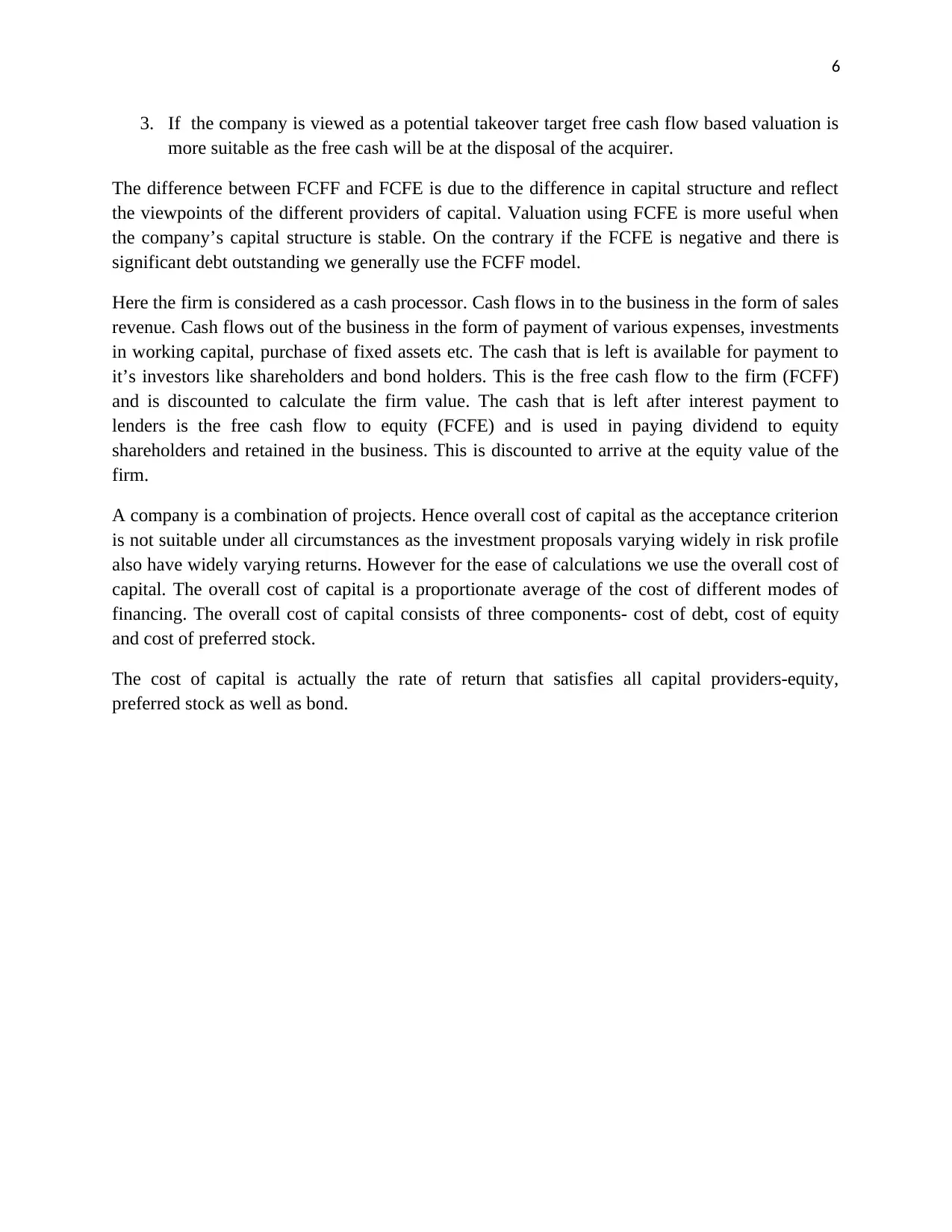
6
3. If the company is viewed as a potential takeover target free cash flow based valuation is
more suitable as the free cash will be at the disposal of the acquirer.
The difference between FCFF and FCFE is due to the difference in capital structure and reflect
the viewpoints of the different providers of capital. Valuation using FCFE is more useful when
the company’s capital structure is stable. On the contrary if the FCFE is negative and there is
significant debt outstanding we generally use the FCFF model.
Here the firm is considered as a cash processor. Cash flows in to the business in the form of sales
revenue. Cash flows out of the business in the form of payment of various expenses, investments
in working capital, purchase of fixed assets etc. The cash that is left is available for payment to
it’s investors like shareholders and bond holders. This is the free cash flow to the firm (FCFF)
and is discounted to calculate the firm value. The cash that is left after interest payment to
lenders is the free cash flow to equity (FCFE) and is used in paying dividend to equity
shareholders and retained in the business. This is discounted to arrive at the equity value of the
firm.
A company is a combination of projects. Hence overall cost of capital as the acceptance criterion
is not suitable under all circumstances as the investment proposals varying widely in risk profile
also have widely varying returns. However for the ease of calculations we use the overall cost of
capital. The overall cost of capital is a proportionate average of the cost of different modes of
financing. The overall cost of capital consists of three components- cost of debt, cost of equity
and cost of preferred stock.
The cost of capital is actually the rate of return that satisfies all capital providers-equity,
preferred stock as well as bond.
3. If the company is viewed as a potential takeover target free cash flow based valuation is
more suitable as the free cash will be at the disposal of the acquirer.
The difference between FCFF and FCFE is due to the difference in capital structure and reflect
the viewpoints of the different providers of capital. Valuation using FCFE is more useful when
the company’s capital structure is stable. On the contrary if the FCFE is negative and there is
significant debt outstanding we generally use the FCFF model.
Here the firm is considered as a cash processor. Cash flows in to the business in the form of sales
revenue. Cash flows out of the business in the form of payment of various expenses, investments
in working capital, purchase of fixed assets etc. The cash that is left is available for payment to
it’s investors like shareholders and bond holders. This is the free cash flow to the firm (FCFF)
and is discounted to calculate the firm value. The cash that is left after interest payment to
lenders is the free cash flow to equity (FCFE) and is used in paying dividend to equity
shareholders and retained in the business. This is discounted to arrive at the equity value of the
firm.
A company is a combination of projects. Hence overall cost of capital as the acceptance criterion
is not suitable under all circumstances as the investment proposals varying widely in risk profile
also have widely varying returns. However for the ease of calculations we use the overall cost of
capital. The overall cost of capital is a proportionate average of the cost of different modes of
financing. The overall cost of capital consists of three components- cost of debt, cost of equity
and cost of preferred stock.
The cost of capital is actually the rate of return that satisfies all capital providers-equity,
preferred stock as well as bond.
⊘ This is a preview!⊘
Do you want full access?
Subscribe today to unlock all pages.

Trusted by 1+ million students worldwide
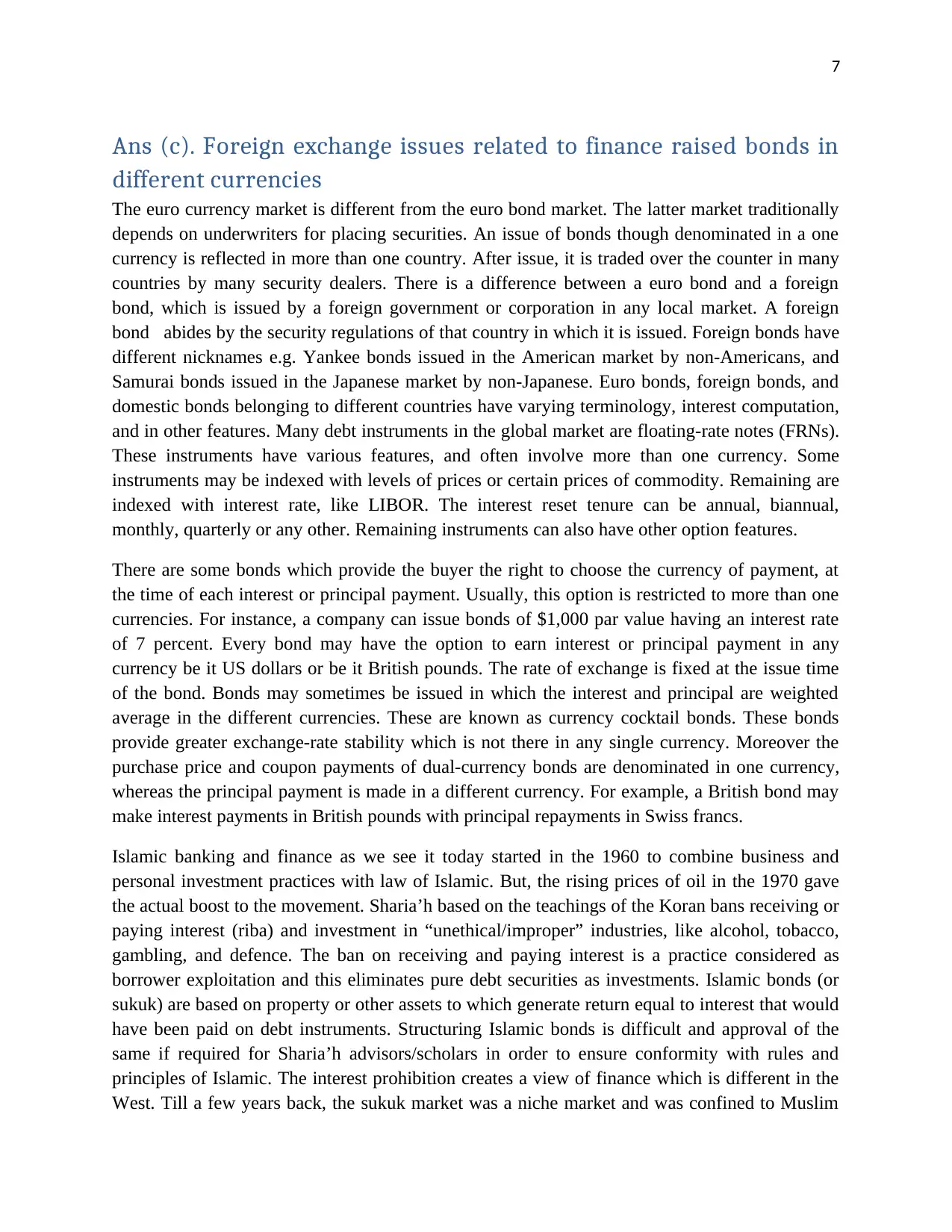
7
Ans (c). Foreign exchange issues related to finance raised bonds in
different currencies
The euro currency market is different from the euro bond market. The latter market traditionally
depends on underwriters for placing securities. An issue of bonds though denominated in a one
currency is reflected in more than one country. After issue, it is traded over the counter in many
countries by many security dealers. There is a difference between a euro bond and a foreign
bond, which is issued by a foreign government or corporation in any local market. A foreign
bond abides by the security regulations of that country in which it is issued. Foreign bonds have
different nicknames e.g. Yankee bonds issued in the American market by non-Americans, and
Samurai bonds issued in the Japanese market by non-Japanese. Euro bonds, foreign bonds, and
domestic bonds belonging to different countries have varying terminology, interest computation,
and in other features. Many debt instruments in the global market are floating-rate notes (FRNs).
These instruments have various features, and often involve more than one currency. Some
instruments may be indexed with levels of prices or certain prices of commodity. Remaining are
indexed with interest rate, like LIBOR. The interest reset tenure can be annual, biannual,
monthly, quarterly or any other. Remaining instruments can also have other option features.
There are some bonds which provide the buyer the right to choose the currency of payment, at
the time of each interest or principal payment. Usually, this option is restricted to more than one
currencies. For instance, a company can issue bonds of $1,000 par value having an interest rate
of 7 percent. Every bond may have the option to earn interest or principal payment in any
currency be it US dollars or be it British pounds. The rate of exchange is fixed at the issue time
of the bond. Bonds may sometimes be issued in which the interest and principal are weighted
average in the different currencies. These are known as currency cocktail bonds. These bonds
provide greater exchange-rate stability which is not there in any single currency. Moreover the
purchase price and coupon payments of dual-currency bonds are denominated in one currency,
whereas the principal payment is made in a different currency. For example, a British bond may
make interest payments in British pounds with principal repayments in Swiss francs.
Islamic banking and finance as we see it today started in the 1960 to combine business and
personal investment practices with law of Islamic. But, the rising prices of oil in the 1970 gave
the actual boost to the movement. Sharia’h based on the teachings of the Koran bans receiving or
paying interest (riba) and investment in “unethical/improper” industries, like alcohol, tobacco,
gambling, and defence. The ban on receiving and paying interest is a practice considered as
borrower exploitation and this eliminates pure debt securities as investments. Islamic bonds (or
sukuk) are based on property or other assets to which generate return equal to interest that would
have been paid on debt instruments. Structuring Islamic bonds is difficult and approval of the
same if required for Sharia’h advisors/scholars in order to ensure conformity with rules and
principles of Islamic. The interest prohibition creates a view of finance which is different in the
West. Till a few years back, the sukuk market was a niche market and was confined to Muslim
Ans (c). Foreign exchange issues related to finance raised bonds in
different currencies
The euro currency market is different from the euro bond market. The latter market traditionally
depends on underwriters for placing securities. An issue of bonds though denominated in a one
currency is reflected in more than one country. After issue, it is traded over the counter in many
countries by many security dealers. There is a difference between a euro bond and a foreign
bond, which is issued by a foreign government or corporation in any local market. A foreign
bond abides by the security regulations of that country in which it is issued. Foreign bonds have
different nicknames e.g. Yankee bonds issued in the American market by non-Americans, and
Samurai bonds issued in the Japanese market by non-Japanese. Euro bonds, foreign bonds, and
domestic bonds belonging to different countries have varying terminology, interest computation,
and in other features. Many debt instruments in the global market are floating-rate notes (FRNs).
These instruments have various features, and often involve more than one currency. Some
instruments may be indexed with levels of prices or certain prices of commodity. Remaining are
indexed with interest rate, like LIBOR. The interest reset tenure can be annual, biannual,
monthly, quarterly or any other. Remaining instruments can also have other option features.
There are some bonds which provide the buyer the right to choose the currency of payment, at
the time of each interest or principal payment. Usually, this option is restricted to more than one
currencies. For instance, a company can issue bonds of $1,000 par value having an interest rate
of 7 percent. Every bond may have the option to earn interest or principal payment in any
currency be it US dollars or be it British pounds. The rate of exchange is fixed at the issue time
of the bond. Bonds may sometimes be issued in which the interest and principal are weighted
average in the different currencies. These are known as currency cocktail bonds. These bonds
provide greater exchange-rate stability which is not there in any single currency. Moreover the
purchase price and coupon payments of dual-currency bonds are denominated in one currency,
whereas the principal payment is made in a different currency. For example, a British bond may
make interest payments in British pounds with principal repayments in Swiss francs.
Islamic banking and finance as we see it today started in the 1960 to combine business and
personal investment practices with law of Islamic. But, the rising prices of oil in the 1970 gave
the actual boost to the movement. Sharia’h based on the teachings of the Koran bans receiving or
paying interest (riba) and investment in “unethical/improper” industries, like alcohol, tobacco,
gambling, and defence. The ban on receiving and paying interest is a practice considered as
borrower exploitation and this eliminates pure debt securities as investments. Islamic bonds (or
sukuk) are based on property or other assets to which generate return equal to interest that would
have been paid on debt instruments. Structuring Islamic bonds is difficult and approval of the
same if required for Sharia’h advisors/scholars in order to ensure conformity with rules and
principles of Islamic. The interest prohibition creates a view of finance which is different in the
West. Till a few years back, the sukuk market was a niche market and was confined to Muslim
Paraphrase This Document
Need a fresh take? Get an instant paraphrase of this document with our AI Paraphraser
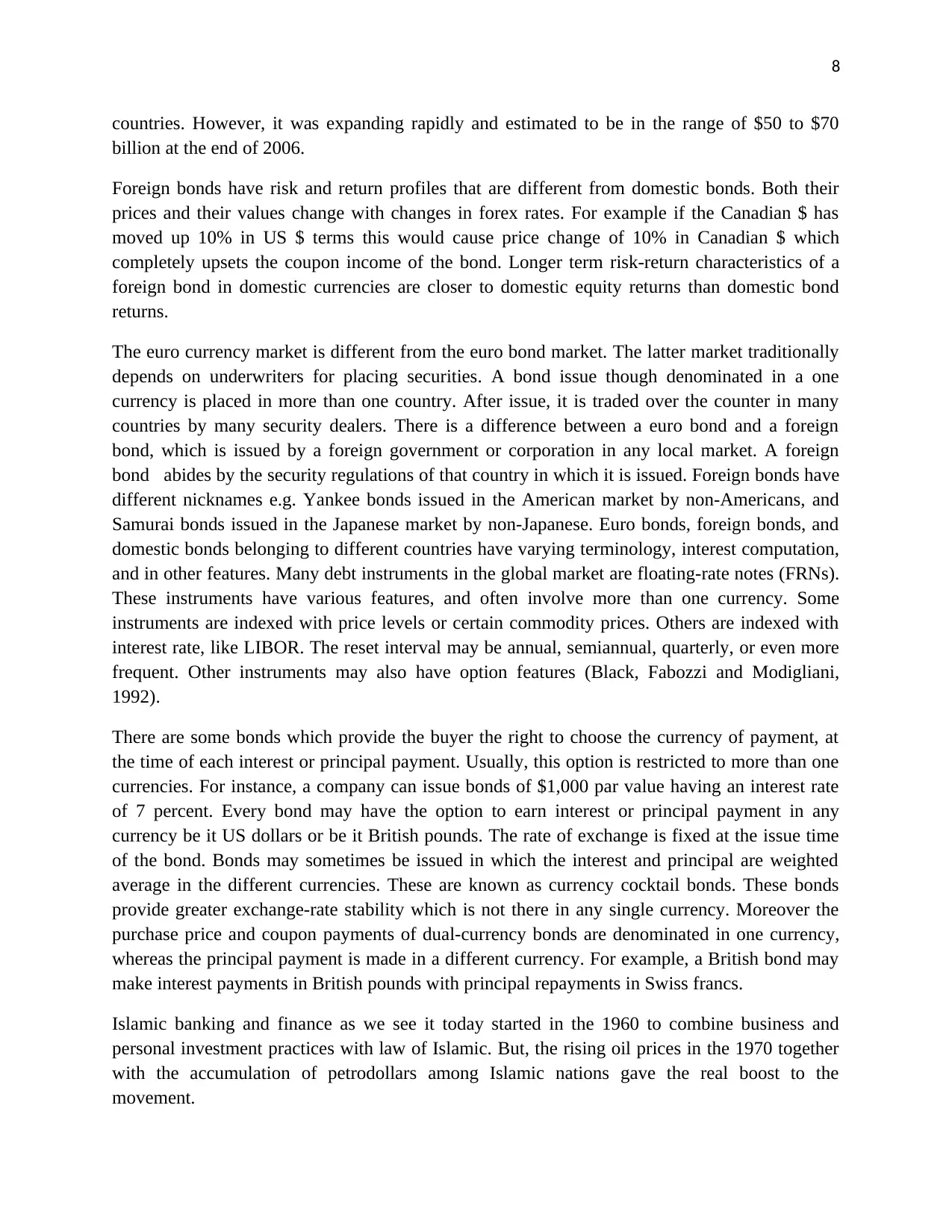
8
countries. However, it was expanding rapidly and estimated to be in the range of $50 to $70
billion at the end of 2006.
Foreign bonds have risk and return profiles that are different from domestic bonds. Both their
prices and their values change with changes in forex rates. For example if the Canadian $ has
moved up 10% in US $ terms this would cause price change of 10% in Canadian $ which
completely upsets the coupon income of the bond. Longer term risk-return characteristics of a
foreign bond in domestic currencies are closer to domestic equity returns than domestic bond
returns.
The euro currency market is different from the euro bond market. The latter market traditionally
depends on underwriters for placing securities. A bond issue though denominated in a one
currency is placed in more than one country. After issue, it is traded over the counter in many
countries by many security dealers. There is a difference between a euro bond and a foreign
bond, which is issued by a foreign government or corporation in any local market. A foreign
bond abides by the security regulations of that country in which it is issued. Foreign bonds have
different nicknames e.g. Yankee bonds issued in the American market by non-Americans, and
Samurai bonds issued in the Japanese market by non-Japanese. Euro bonds, foreign bonds, and
domestic bonds belonging to different countries have varying terminology, interest computation,
and in other features. Many debt instruments in the global market are floating-rate notes (FRNs).
These instruments have various features, and often involve more than one currency. Some
instruments are indexed with price levels or certain commodity prices. Others are indexed with
interest rate, like LIBOR. The reset interval may be annual, semiannual, quarterly, or even more
frequent. Other instruments may also have option features (Black, Fabozzi and Modigliani,
1992).
There are some bonds which provide the buyer the right to choose the currency of payment, at
the time of each interest or principal payment. Usually, this option is restricted to more than one
currencies. For instance, a company can issue bonds of $1,000 par value having an interest rate
of 7 percent. Every bond may have the option to earn interest or principal payment in any
currency be it US dollars or be it British pounds. The rate of exchange is fixed at the issue time
of the bond. Bonds may sometimes be issued in which the interest and principal are weighted
average in the different currencies. These are known as currency cocktail bonds. These bonds
provide greater exchange-rate stability which is not there in any single currency. Moreover the
purchase price and coupon payments of dual-currency bonds are denominated in one currency,
whereas the principal payment is made in a different currency. For example, a British bond may
make interest payments in British pounds with principal repayments in Swiss francs.
Islamic banking and finance as we see it today started in the 1960 to combine business and
personal investment practices with law of Islamic. But, the rising oil prices in the 1970 together
with the accumulation of petrodollars among Islamic nations gave the real boost to the
movement.
countries. However, it was expanding rapidly and estimated to be in the range of $50 to $70
billion at the end of 2006.
Foreign bonds have risk and return profiles that are different from domestic bonds. Both their
prices and their values change with changes in forex rates. For example if the Canadian $ has
moved up 10% in US $ terms this would cause price change of 10% in Canadian $ which
completely upsets the coupon income of the bond. Longer term risk-return characteristics of a
foreign bond in domestic currencies are closer to domestic equity returns than domestic bond
returns.
The euro currency market is different from the euro bond market. The latter market traditionally
depends on underwriters for placing securities. A bond issue though denominated in a one
currency is placed in more than one country. After issue, it is traded over the counter in many
countries by many security dealers. There is a difference between a euro bond and a foreign
bond, which is issued by a foreign government or corporation in any local market. A foreign
bond abides by the security regulations of that country in which it is issued. Foreign bonds have
different nicknames e.g. Yankee bonds issued in the American market by non-Americans, and
Samurai bonds issued in the Japanese market by non-Japanese. Euro bonds, foreign bonds, and
domestic bonds belonging to different countries have varying terminology, interest computation,
and in other features. Many debt instruments in the global market are floating-rate notes (FRNs).
These instruments have various features, and often involve more than one currency. Some
instruments are indexed with price levels or certain commodity prices. Others are indexed with
interest rate, like LIBOR. The reset interval may be annual, semiannual, quarterly, or even more
frequent. Other instruments may also have option features (Black, Fabozzi and Modigliani,
1992).
There are some bonds which provide the buyer the right to choose the currency of payment, at
the time of each interest or principal payment. Usually, this option is restricted to more than one
currencies. For instance, a company can issue bonds of $1,000 par value having an interest rate
of 7 percent. Every bond may have the option to earn interest or principal payment in any
currency be it US dollars or be it British pounds. The rate of exchange is fixed at the issue time
of the bond. Bonds may sometimes be issued in which the interest and principal are weighted
average in the different currencies. These are known as currency cocktail bonds. These bonds
provide greater exchange-rate stability which is not there in any single currency. Moreover the
purchase price and coupon payments of dual-currency bonds are denominated in one currency,
whereas the principal payment is made in a different currency. For example, a British bond may
make interest payments in British pounds with principal repayments in Swiss francs.
Islamic banking and finance as we see it today started in the 1960 to combine business and
personal investment practices with law of Islamic. But, the rising oil prices in the 1970 together
with the accumulation of petrodollars among Islamic nations gave the real boost to the
movement.
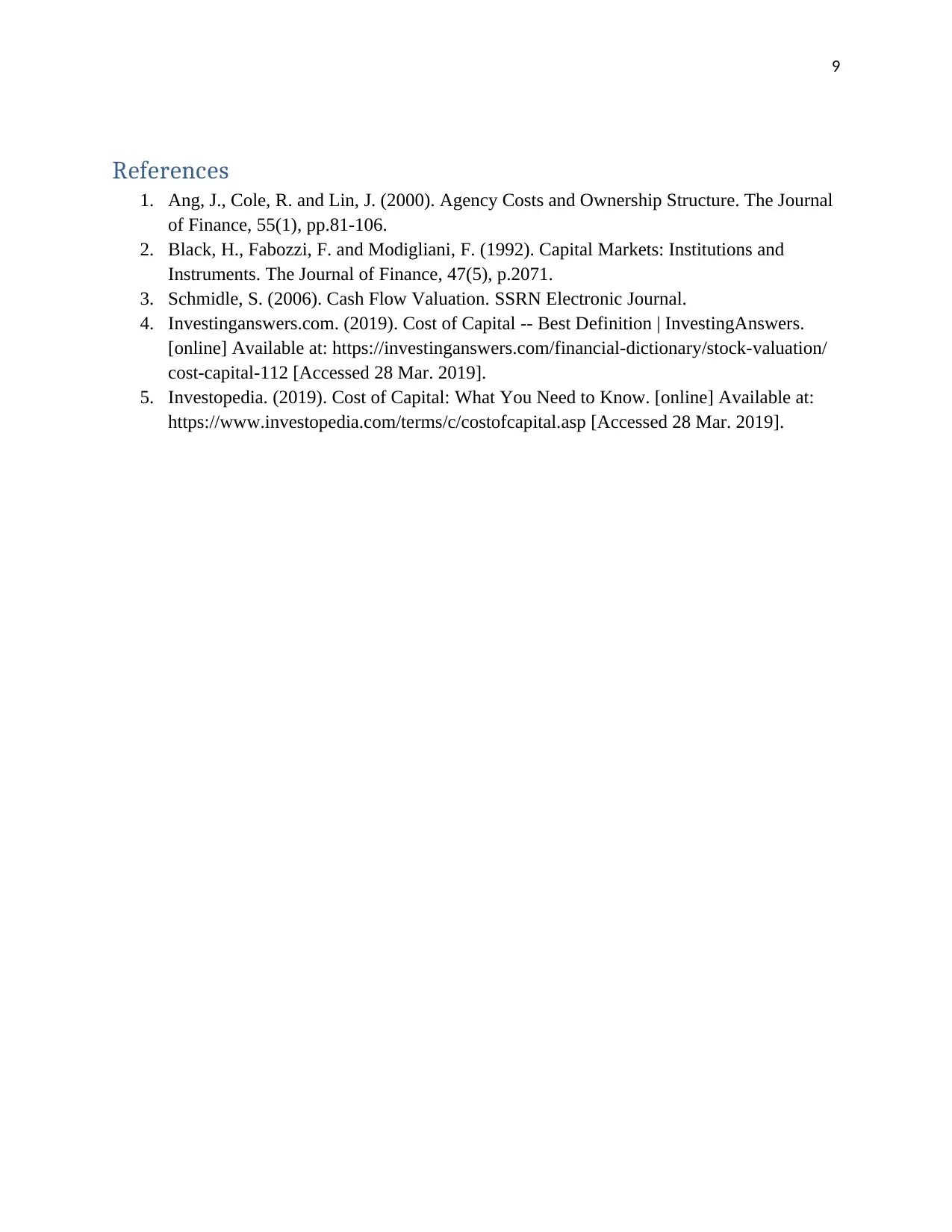
9
References
1. Ang, J., Cole, R. and Lin, J. (2000). Agency Costs and Ownership Structure. The Journal
of Finance, 55(1), pp.81-106.
2. Black, H., Fabozzi, F. and Modigliani, F. (1992). Capital Markets: Institutions and
Instruments. The Journal of Finance, 47(5), p.2071.
3. Schmidle, S. (2006). Cash Flow Valuation. SSRN Electronic Journal.
4. Investinganswers.com. (2019). Cost of Capital -- Best Definition | InvestingAnswers.
[online] Available at: https://investinganswers.com/financial-dictionary/stock-valuation/
cost-capital-112 [Accessed 28 Mar. 2019].
5. Investopedia. (2019). Cost of Capital: What You Need to Know. [online] Available at:
https://www.investopedia.com/terms/c/costofcapital.asp [Accessed 28 Mar. 2019].
References
1. Ang, J., Cole, R. and Lin, J. (2000). Agency Costs and Ownership Structure. The Journal
of Finance, 55(1), pp.81-106.
2. Black, H., Fabozzi, F. and Modigliani, F. (1992). Capital Markets: Institutions and
Instruments. The Journal of Finance, 47(5), p.2071.
3. Schmidle, S. (2006). Cash Flow Valuation. SSRN Electronic Journal.
4. Investinganswers.com. (2019). Cost of Capital -- Best Definition | InvestingAnswers.
[online] Available at: https://investinganswers.com/financial-dictionary/stock-valuation/
cost-capital-112 [Accessed 28 Mar. 2019].
5. Investopedia. (2019). Cost of Capital: What You Need to Know. [online] Available at:
https://www.investopedia.com/terms/c/costofcapital.asp [Accessed 28 Mar. 2019].
⊘ This is a preview!⊘
Do you want full access?
Subscribe today to unlock all pages.

Trusted by 1+ million students worldwide
1 out of 9
Related Documents
Your All-in-One AI-Powered Toolkit for Academic Success.
+13062052269
info@desklib.com
Available 24*7 on WhatsApp / Email
![[object Object]](/_next/static/media/star-bottom.7253800d.svg)
Unlock your academic potential
Copyright © 2020–2026 A2Z Services. All Rights Reserved. Developed and managed by ZUCOL.





